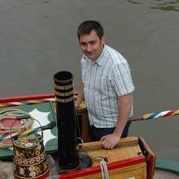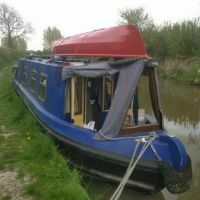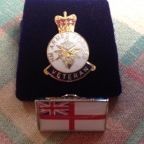-
Posts
2,132 -
Joined
-
Last visited
-
Days Won
1
IanM last won the day on December 2 2016
IanM had the most liked content!
About IanM
- Birthday 27/04/1978
Profile Information
-
Gender
Male
-
Location
Manningtree, Essex
-
Boat Name
Piglet
Recent Profile Visitors
10,526 profile views
IanM's Achievements
-
IanM started following Stop plank slots. , Symbol on bridge , Sloping paddle gear and 5 others
-
You can be really geeky and have a spreadsheet of all the OS Bench Marks in the UK 🤓 The one shown as being on the canal bridge abutment is on Blakeley Hall Bridge on the BCN old main line.
-
I was going to mention the Thames & Severn and Stroudwater Navigation. It's a bit of a mix to be honest. Most, not all, of the T&S locks from Wallbridge to Brimscombe have the paddles sloping on the downstream face of a flattened-off arched chamber underneath the lockside as above. These culverts enter the lock in the cill. The rest to the Thames seem to be on the upstream face of a flat wall perpendicular to the towpath and are very slightly sloping. The culverts for these enter the lock in the side walls. Both the above wind at right angles to the lock sides so in the case of the latter you are actually winding in to the canal. All the Stroudwater locks have vertical paddles in the upper gate recesses which originally wound facing into the canal apart from Whitminster Lock which has the arrangement the same as the lower T&S except for the culverts emptying into the sides of the lock. I haven't got any pictures here to illustrate it but I'll try to add some later.
-

Building a Category C narrowboat!
IanM replied to dreamboater's topic in Boat Building & Maintenance
I have seen a narrow boat up here on the Stour estuary in Essex before. No idea where it came from or where it went afterwards. -
It is the Thames & Severn but further east from Chalford. It’s Daneway Bridge with the wharf cottage on the right. Beneath the bridge is the infilled Daneway lock which currently serves as the car park for the Daneway Inn. It’s the last lock up to the summit with Sapperton Tunnel not far away.
-
Seems that no one really knows the origin of 4' 8 1/2" https://en.wikipedia.org/wiki/Standard-gauge_railway
-
I've not seen any image of any loco that I can recall and I'm trying to think of anywhere else it could have been used. The other pictures taken at the same location as yours just show one or two small trucks the same as in your photo. The location in your picture is marked quarry in this map. The GWR Cirencester Branch is in the top left. And the location today. https://www.google.com/maps/@51.692671,-1.9762233,355m/data=!3m1!1e3?entry=ttu
-
Thames & Severn Canal at Bluehouse.
-
Enlarged picture of Raven from the other end to my previous picture showing the plates being discussed. Actually it looks to be more of a single plate as it wraps around the stern but whatever
-
It’s not. As I mentioned earlier, Achilles was a butty owned by Birmingham & Midland in Gas Street. It went from them to Roger at Braunston who then cut it in two. Raven (the name given to it by Willow Wren) was another butty and had a full length cabin fitted but I forget its original name and was moored outside Roger’s yard at one point but I’m pretty sure it never got cut in two by him as I saw it still intact somewhere else afterwards. Edited to add: Raven was originally the GUCCC butty Hydrus.
-
Achilles used to belong to Birmingham and Midland and was moored in Gas Street basin.
-
Is that the one in question or the one in Foxton village itself? Edited to add: According to the stoppage notice it is bridge 4 so not the footbridge at the junction as per the OP, rather the larger vehicle bridge in the village.
-
Knowle locks are the ones with the larger culverts so I imagine that has something to do with it.
-

There and back again: Saul Junction to Ebley by canoe
IanM replied to Francis Herne's topic in Cruise Diaries & Reports
We added that beam to support the centre post for the stop planks. The centre post was added to add a bit of support to the centre of the planks as they are 16 feet long and we were using them over an extended period of time. The lock had a fall of 6 feet or so before the ship canal was built when the level change became a few inches meaning that quite often the top and bottom gates were left wide open. At some point concrete copings were added to raise the level of the walls a bit so that the lock had to be used and this is can be seen today. The bottom of the lock is still at the original pre-ship canal level so there is essentially a full lock of water there. In the 1990s we sheet piled a dam at the lower end to excavate the chamber (it had been infilled) all the way down to the original bottom which is constructed out of stone blocks. A concrete plinth was then constructed up to 6 foot below water level which we could then sit stop planks on that along with a socket for the centre post. At other locks we had used cables to anchor the post but we had a beam lying around which did the job instead. The gas pipe as you refer to it is actually part of the countrywide Exolum aviation fuel pipeline. https://en.wikipedia.org/wiki/Exolum_Pipeline_System -
I can't think of any emergency where the ones at the lower end of the lock would be of any use and they really would only get used to de-water the lock. The ones at the head of the lock would be more useful and easier to put in too.
-
They would have been put in the slots by a maintenance team with the necessary access to boats, ropes, etc and not just one lonely lock keeper. Plus they do float a bit too.











